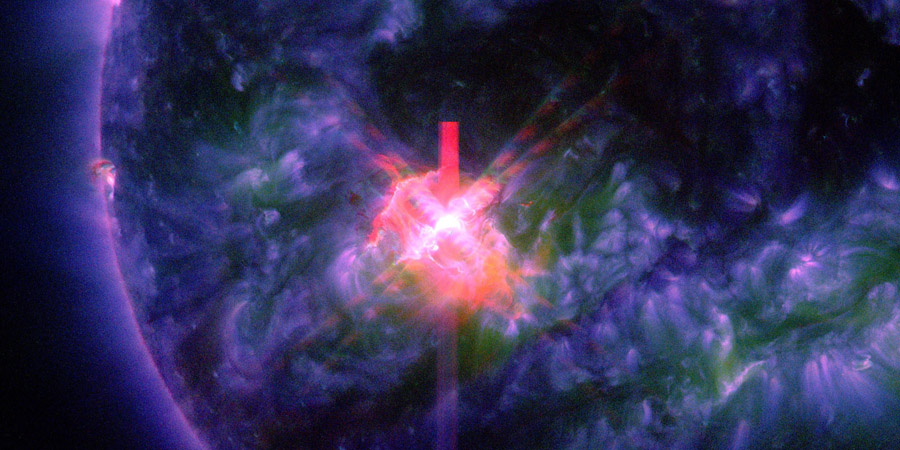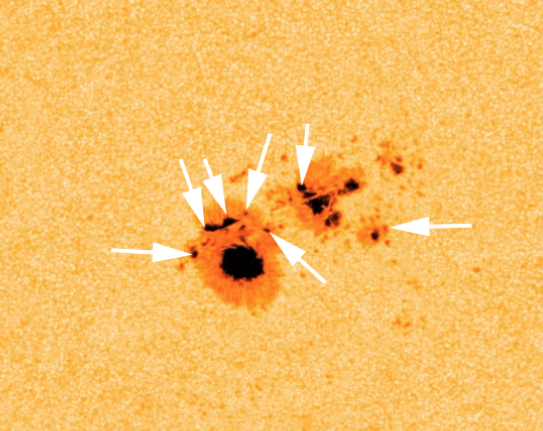Four M-class and an X2.2 solar flare from sunspot region 2297
Wednesday, 11 March 2015 18:59 UTC

It took a little patience but sunspot region 2297 delivered the first X-class solar flare of this year: it was the source of a major X2.2 (R3-strong) solar flare around 16:22 UTC. Sunspot region 2297 is now facing Earth so the big question on everyone's lips is: did it produce a coronal mass ejection and will it come towards Earth?
Major X2.2 solar #flare - Follow live on http://t.co/XHATH0OOfT pic.twitter.com/CVRbnUxQfb
— SpaceWeatherLive (@_SpaceWeather_) 11 maart 2015
Let's start with the good news first: a coronal mass ejection has likely been launched. Difference imagery from SDO shows that it was an eruptive event but those with good eyes can see that the bulk of the ejecta looks to be heading east and away for Earth. There is still a good chance that part of this coronal mass ejection comes towards Earth but to be sure of that we need to have coronagraph imagery from SOHO, something that is not yet available at this time.
We also issue a warning for a possible minor solar radiation storm but it is still unlikely that the S1 threshold will be reached as sunspot region 2297 did not pass the central meridian yet.

Animation: The eruptive nature of the X2.2 solar flare can be seen nicely in these difference images from NASA SDO. Note the bulk of the ejecta looks to be heading to the east.
M-class solar flares
There were also a number of lesser M-class solar flares (M2.9 at 00:02 UTC, M1.8 at 07:18, M2.6 at 07:57 UTC, M1.0 at 18:51 UTC) today but coronagraph imagery is also very limited for these events. We can say for sure that the M2.9 solar flare from 00:02 UTC did launch a small coronal mass ejection but that was directed away from Earth. We need more imagery from SOHO for the other events.
NOAA SWPC alerts regarding the X2.2 solar flare
ALERT: X-Ray Flux exceeded M5 Threshold Reached: 2015 Mar 11 1617 UTC NOAA Scale: R2 - Moderate
ALERT: Type II Radio Emission Begin Time: 2015 Mar 11 1623 UTC Estimated Velocity: 1461 km/s
ALERT: Type IV Radio Emission Begin Time: 2015 Mar 11 1638 UTC
SUMMARY: X-ray Event exceeded X1 Begin Time: 2015 Mar 11 1611 UTC Maximum Time: 2015 Mar 11 1622 UTC End Time: 2015 Mar 11 1629 UTC X-ray Class: X2.1 Optical Class: 2b Location: S17E23 NOAA Scale: R3 - Strong
Sunspot region 2297
Sunspot region 2297 continued to grow during the day, increasing both in spot count and magnetic complexity. Several new delta spots emerged near the leading spot in the eastern part of the region but they are not yet very compact. In the cluster west of the leading spot a strong delta spot sits close to the spot of opposite polarity making it very complex. The potential for more solar flares from this sunspot region increased a lot during the day with M-class flares being very likely and a fair chance for another X-class event. Now that the sunspot region is almost near the center of the earth-facing solar disk, there is an increasing possibility that a proton event might occur and any coronal mass ejections will head towards Earth.
M-class flare probability for the coming 24 hours: 80% chance
X-class flare probability for the coming 24 hours: 30% chance

Image: Sunspot region 2297 as seen by NASA SDO. Delta sunspots are indicated by arrows.
Thank you for reading this article! Did you have any trouble with the technical terms used in this article? Our help section is the place to be where you can find in-depth articles, a FAQ and a list with common abbreviations. Still puzzled? Just post on our forum where we will help you the best we can!
Latest news
Latest forum messages
Support SpaceWeatherLive.com!
A lot of people come to SpaceWeatherLive to follow the Solar activity or if there is a chance to see the aurora, but with more traffic comes higher costs to keep the servers online. If you like SpaceWeatherLive and want to support the project you can choose a subscription for an ad-free site or consider a donation. With your help we can keep SpaceWeatherLive online!
Space weather facts
| Last X-flare | 2025/12/08 | X1.1 |
| Last M-flare | 2025/12/19 | M1.0 |
| Last geomagnetic storm | 2025/12/12 | Kp5 (G1) |
| Spotless days | |
|---|---|
| Last spotless day | 2022/06/08 |
| Monthly mean Sunspot Number | |
|---|---|
| November 2025 | 91.8 -22.8 |
| December 2025 | 125.7 +33.9 |
| Last 30 days | 109.3 +18.1 |





